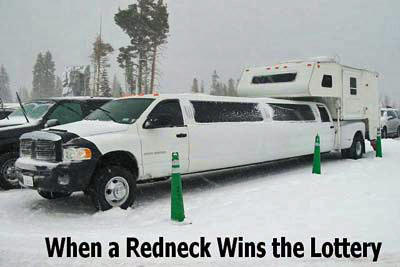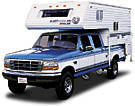|
Matching your Truck to
a Slide in Camper for Towing
H. Kent Sundling,
MrTruck.com
 Look
at trucks with the big Lance campers on them. They’ll have air
bags or extra overloads and sometimes 19.5” or even 22” tires. It’s
nice to take your house with you to the woods, mountains and then
there’s hunting. If you need to haul horses too for Elk hunting or just
horsing around, it’s important to get the specs figured out. Payload and
trailer tongue weight come from the same capacity limit. Which makes
hard sided heavy truck campers difficult to use with trailers. It’s
fairly common for a ¾ ton truck to be overloaded with a hard sided slide
in camper. Yes a truck camper and bumper pull trailers are easier to get
in tight places, like trailheads and national forests. The new Ford F450
pickup truck is the exception with payload enough for a large slide out
hard sided camper and a 3 horse conventional tow trailer or ATV trailer.
For ½ and some ¾ ton trucks, a soft sided popup camper is the best
choice to keep the payload weight down so there’s room for a trailers
tongue weight. The formula to determine what camper weight and what
trailer weight fits your truck, we need a little info. You can get
some numbers from your trucks owner’s manual or the truck manufactures
towing guide, but to make it simple we’ll just look at the manufacture
safety compliance certification label on your truck and trailer. These
tags have the GVWR, axle ratings, tire pressure ratings and date of
manufacture. With truck payload don’t forget rear axle weight as
along with GVWR it’s the easiest to exceed. Look
at trucks with the big Lance campers on them. They’ll have air
bags or extra overloads and sometimes 19.5” or even 22” tires. It’s
nice to take your house with you to the woods, mountains and then
there’s hunting. If you need to haul horses too for Elk hunting or just
horsing around, it’s important to get the specs figured out. Payload and
trailer tongue weight come from the same capacity limit. Which makes
hard sided heavy truck campers difficult to use with trailers. It’s
fairly common for a ¾ ton truck to be overloaded with a hard sided slide
in camper. Yes a truck camper and bumper pull trailers are easier to get
in tight places, like trailheads and national forests. The new Ford F450
pickup truck is the exception with payload enough for a large slide out
hard sided camper and a 3 horse conventional tow trailer or ATV trailer.
For ½ and some ¾ ton trucks, a soft sided popup camper is the best
choice to keep the payload weight down so there’s room for a trailers
tongue weight. The formula to determine what camper weight and what
trailer weight fits your truck, we need a little info. You can get
some numbers from your trucks owner’s manual or the truck manufactures
towing guide, but to make it simple we’ll just look at the manufacture
safety compliance certification label on your truck and trailer. These
tags have the GVWR, axle ratings, tire pressure ratings and date of
manufacture. With truck payload don’t forget rear axle weight as
along with GVWR it’s the easiest to exceed.
 This
sticker (label) is in the drivers door frame near the door handle of
your truck. You’re looking for the GVWR number. This means Gross Vehicle
Weight Rating, which is the max weight with passengers, fuel, cargo, and
truck. Payload is what your truck can carry as cargo and trailer tongue
weight. Truck manufactures figure payload rating by subtracting curb
weight (empty truck with one 150 lb passenger and tank of fuel) from
GVWR. The simple way for you to do this is to weigh your empty truck
(at a truck stop or feed store) with what you plan on carrying on your
trips like passengers, coolers etc. Then subtract that weight from the
GVWR you found in the label in your truck. Now you have the real
payload number that will show you what’s left for your camper and
trailer. Next look at the trailer manufacture label on the trailer
tongue, once again looking for the GVWR. If you want to weigh your empty
trailer, you’ll have the real number of what weight you can put in the
trailer. Generally conventional tow trailers have a 10% tongue weight
with goosenecks at 20%. These are the numbers that the SAE will be
coming out with as the standard for the industry. This
sticker (label) is in the drivers door frame near the door handle of
your truck. You’re looking for the GVWR number. This means Gross Vehicle
Weight Rating, which is the max weight with passengers, fuel, cargo, and
truck. Payload is what your truck can carry as cargo and trailer tongue
weight. Truck manufactures figure payload rating by subtracting curb
weight (empty truck with one 150 lb passenger and tank of fuel) from
GVWR. The simple way for you to do this is to weigh your empty truck
(at a truck stop or feed store) with what you plan on carrying on your
trips like passengers, coolers etc. Then subtract that weight from the
GVWR you found in the label in your truck. Now you have the real
payload number that will show you what’s left for your camper and
trailer. Next look at the trailer manufacture label on the trailer
tongue, once again looking for the GVWR. If you want to weigh your empty
trailer, you’ll have the real number of what weight you can put in the
trailer. Generally conventional tow trailers have a 10% tongue weight
with goosenecks at 20%. These are the numbers that the SAE will be
coming out with as the standard for the industry.
There are methods of weighing your loaded trailers tongue weight and
scales made just for that or you can take your trailers GVWR number from
the tag on your trailer times 10 % and consider that the tongue weight.
Take the payload number from your truck that we figured earlier and
subtract the loaded trailer tongue weight (10%). Now you know what’s
left over for the slide in truck camper. Not much. This leaves out most
½ ton trucks except for the lightest soft side popup campers. Something
to think about when you buy your trailer, you need them light.
Same
info you need to find out about the slide in camper, the GVWR on it’s
factory label. That’s what you need as real payload after the trailer
tongue weight and empty truck weight. We’ll do the math on my truck. A
Ford F250, GVWR 10,000 lbs, empty truck weight 7500 lbs equals 2500 lbs
payload. Now take a conventional trailer 2 horse with a GVWR of 6000 lbs
times 10% equals 600 lbs. Subtract the 600 lbs tongue weight from the
trucks 2500 lb payload capacity and you have 1900 lbs left for the GVWR
(loaded) of your slide in truck camper. You can find popup campers at
that weight but few hard sided campers. Also on the safety compliance
certification label is axle weight rating. You don’t want to exceed the
GAWR (gross axle weight rating) with you’re loaded with trailer. That
you can also do at the feed store or truck stop, weigh each axle on your
truck and trailer and see if you are under the GAWR. Have FUN, we’ll
save Gross Combination Weight Rating for another time.
|